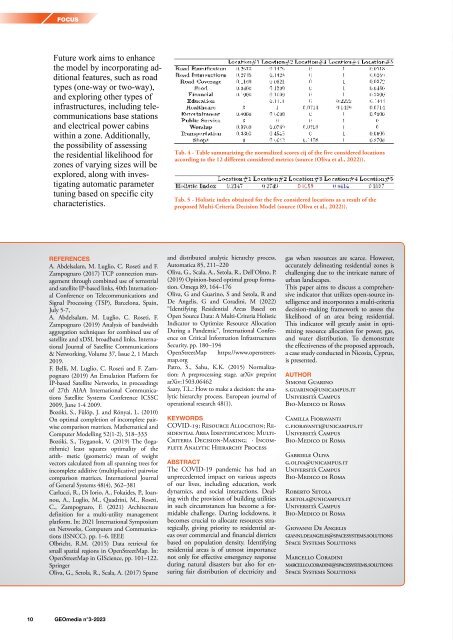GEOmedia_3_2023
EUMAP During the recent pandemic period, the world's attention has shifted towards the healthcare sector, with world leaders striving to avoid the collapse of their national healthcare systems; the economy has entered an artificial coma, while utility systems, including energy, water, telecommunications and waste management systems, have been asked to act immediately in response to these unprecedented conditions, placing extreme pressure on public utility systems.
EUMAP
During the recent pandemic period, the world's attention has shifted towards the healthcare sector, with world leaders striving to avoid the collapse of their national healthcare systems; the economy has entered an artificial coma, while utility systems, including energy, water, telecommunications and waste management systems, have been asked to act immediately in response to these unprecedented conditions, placing extreme pressure on public utility systems.
You also want an ePaper? Increase the reach of your titles
YUMPU automatically turns print PDFs into web optimized ePapers that Google loves.
FOCUS<br />
Future work aims to enhance<br />
the model by incorporating additional<br />
features, such as road<br />
types (one-way or two-way),<br />
and exploring other types of<br />
infrastructures, including telecommunications<br />
base stations<br />
and electrical power cabins<br />
within a zone. Additionally,<br />
the possibility of assessing<br />
the residential likelihood for<br />
zones of varying sizes will be<br />
explored, along with investigating<br />
automatic parameter<br />
tuning based on specific city<br />
characteristics.<br />
Tab. 4 - Table summarizing the normalized scores cij of the five considered locations<br />
according to the 12 different considered metrics (source (Oliva et al., 2022)).<br />
Tab. 5 - Holistic index obtained for the five considered locations as a result of the<br />
proposed Multi-Criteria Decision Model (source (Oliva et al., 2022)).<br />
REFERENCES<br />
A. Abdelsalam, M. Luglio, C. Roseti and F.<br />
Zampognaro (2017) TCP connection management<br />
through combined use of terrestrial<br />
and satellite IP-based links, 40th International<br />
Conference on Telecommunications and<br />
Signal Processing (TSP), Barcelona, Spain,<br />
July 5-7,<br />
A. Abdelsalam, M. Luglio, C. Roseti, F.<br />
Zampognaro (2019) Analysis of bandwidth<br />
aggregation techniques for combined use of<br />
satellite and xDSL broadband links, International<br />
Journal of Satellite Communications<br />
& Networking, Volume 37, Issue 2, 1 March<br />
2019.<br />
F. Belli, M. Luglio, C. Roseti and F. Zampognaro<br />
(2019) An Emulation Platform for<br />
IP-based Satellite Networks, in proceedings<br />
of 27th AIAA International Communications<br />
Satellite Systems Conference ICSSC<br />
2009, June 1-4 2009.<br />
Bozóki, S., Fülöp, J. and Rónyai, L. (2010)<br />
On optimal completion of incomplete pairwise<br />
comparison matrices. Mathematical and<br />
Computer Modelling 52(1-2), 318–333<br />
Bozóki, S., Tsyganok, V. (2019) The (logarithmic)<br />
least squares optimality of the<br />
arith- metic (geometric) mean of weight<br />
vectors calculated from all spanning trees for<br />
incomplete additive (multiplicative) pairwise<br />
comparison matrices. International Journal<br />
of General Systems 48(4), 362–381<br />
Carlucci, R., Di Iorio, A., Fokaides, P., Ioannou,<br />
A., Luglio, M., Quadrini, M., Roseti,<br />
C., Zampognaro, F. (2021) Architecture<br />
definition for a multi-utility management<br />
platform. In: 2021 International Symposium<br />
on Networks, Computers and Communications<br />
(ISNCC). pp. 1–6. IEEE<br />
Olbricht, R.M. (2015) Data retrieval for<br />
small spatial regions in OpenStreetMap. In:<br />
OpenStreetMap in GIScience, pp. 101–122.<br />
Springer<br />
Oliva, G., Setola, R., Scala, A. (2017) Sparse<br />
and distributed analytic hierarchy process.<br />
Automatica 85, 211–220<br />
Oliva, G., Scala, A., Setola, R., Dell’Olmo, P.<br />
(2019) Opinion-based optimal group formation.<br />
Omega 89, 164–176<br />
Oliva, G and Guarino, S and Setola, R and<br />
De Angelis, G and Coradini, M (2022)<br />
“Identifying Residential Areas Based on<br />
Open Source Data: A Multi-Criteria Holistic<br />
Indicator to Optimize Resource Allocation<br />
During a Pandemic”, International Conference<br />
on Critical Information Infrastructures<br />
Security, pp. 180–194<br />
OpenStreetMap https://www.openstreetmap.org<br />
Patro, S., Sahu, K.K. (2015) Normalization:<br />
A preprocessing stage. arXiv preprint<br />
arXiv:1503.06462<br />
Saaty, T.L.: How to make a decision: the analytic<br />
hierarchy process. European journal of<br />
operational research 48(1).<br />
KEYWORDS<br />
COVID-19; Resource Allocation; Residential<br />
Area Identification; Multi-<br />
Criteria Decision-Making; · Incomplete<br />
Analytic Hierarchy Process<br />
ABSTRACT<br />
The COVID-19 pandemic has had an<br />
unprecedented impact on various aspects<br />
of our lives, including education, work<br />
dynamics, and social interactions. Dealing<br />
with the provision of building utilities<br />
in such circumstances has become a formidable<br />
challenge. During lockdowns, it<br />
becomes crucial to allocate resources strategically,<br />
giving priority to residential areas<br />
over commercial and financial districts<br />
based on population density. Identifying<br />
residential areas is of utmost importance<br />
not only for effective emergency response<br />
during natural disasters but also for ensuring<br />
fair distribution of electricity and<br />
gas when resources are scarce. However,<br />
accurately delineating residential zones is<br />
challenging due to the intricate nature of<br />
urban landscapes.<br />
This paper aims to discuss a comprehensive<br />
indicator that utilizes open-source intelligence<br />
and incorporates a multi-criteria<br />
decision-making framework to assess the<br />
likelihood of an area being residential.<br />
This indicator will greatly assist in optimizing<br />
resource allocation for power, gas,<br />
and water distribution. To demonstrate<br />
the effectiveness of the proposed approach,<br />
a case study conducted in Nicosia, Cyprus,<br />
is presented.<br />
AUTHOR<br />
Simone Guarino<br />
s.guarino@unicampus.it<br />
Università Campus<br />
Bio-Medico di Roma<br />
Camilla Fioravanti<br />
c.fioravanti@unicampus.it<br />
Università Campus<br />
Bio-Medico di Roma<br />
Gabriele Oliva<br />
g.oliva@unicampus.it<br />
Università Campus<br />
Bio-Medico di Roma<br />
Roberto Setola<br />
r.setola@unicampus.it<br />
Università Campus<br />
Bio-Medico di Roma<br />
Giovanni De Angelis<br />
gianni.deangelis@spacesystems.solutions<br />
Space Systems Solutions<br />
Marcello Coradini<br />
marcello.coradini@spacesystems.solutions<br />
Space Systems Solutions<br />
10 <strong>GEOmedia</strong> n°3-<strong>2023</strong>

















